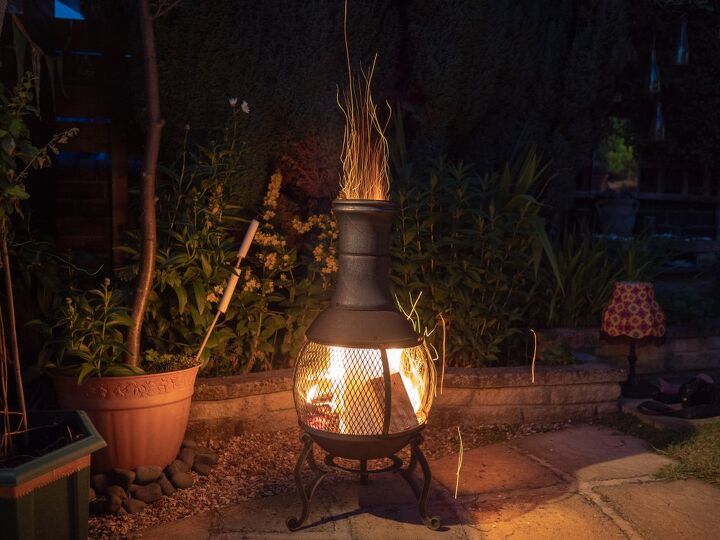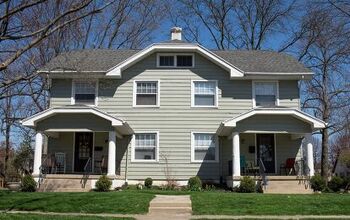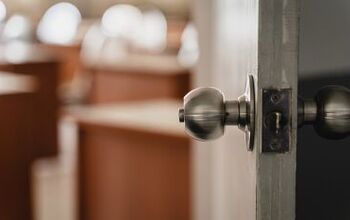Fire Pit Vs. Chiminea: What Are The Major Differences?

If you are redesigning your outdoor space you have all sorts of decisions to make. There are endless ways to spruce up your outdoor living space, like building a deck, installing a hot tub, or even by purchasing a stunning fire feature. If you decide to purchase a fire feature, you may find yourselves at a crossroads between buying a fire pit of a chiminea. When it comes to chimineas and fire pits, many people often wonder what exactly the difference is and which option is better.
Fire pits are the superior fire feature for those looking for a good light and heat source. They are also preferable to chimineas when it comes to social gatherings, as you can easily sit around them in a circle. A chiminea is generally safer and leaves you smelling less smokey. They also fit great in smaller spaces where fire pits are not a suitable option.
Both a chiminea or fire pit is a great way to enhance your backyard. It can make it more inviting and encourage you and guests to enjoy your outdoor space well into the evening and even into the colder months. As you are deciding whether to purchase a fire pit or a chiminea, you should first understand the major differences between these two fire features in order to make the best decision for you.
Fire Pits And Chiminea: What’s The Difference?
A Fire pit and chiminea are both outdoor fire features. For the most part they are both easy to install. In fact, many fire pits and chiminea are easily transportable. While both are great additions to the outdoors, and share several similarities, they are not completely alike. In fact there are some major differences between fire pits and chiminea.
Shape And Size
A chiminea is designed like a detached chimney. They are essentially free-standing fireplaces. A chiminea is tall, with generally one side opening. This opening is where you place the feel (dry wood generally). The smoke then filters upwards and out the tall top of the chiminea.
Fire pits, on the other hand, are usually mostly open flame. Where chimineas are tall and more narrow, fire pits tend to be short and wide. Still, fire pits can be very large, especially professionally installed fire pits in large outdoor spaces. Fire pits are frequently round, and have seating in a 360 degree fashion, allowing for circular social gatherings.
How They Give Off Heat and Light
A Chiminea and a fire pit also have different ways of giving off heat and light. When it comes to fire pits, they give off lots of light, especially when the fuel source is fresh and in flames. Fire pits are not often covered, so this means all the light coming from the fire pit can shine as a light source. This also allows all the heat to disperse directly from the fire pit. This makes it very warm close to the fire pit.
Chiminea only give off light through their small opening. This light is often more of a glow. It gives a subdued ambient light. They are a heat source, but the heat radiates off the surface of the chiminea. Where a fire pit gives off heat in a rush that is immediate but fleeting, a chimney heats more like a radiator would, giving more controlled but weaker heat.
What Materials They Are Made From
Chimineas can be made of cast iron or cast aluminum, but the classic style is the more traditional fire clay chiminea. They are normally composed of one large body piece, which can be quite heavy but is also transportable.
Fire pits range significantly in what they are made of. They can be made of metal, especially if they are of the lower-budget portable variety. Permanent structured fire pits are more often made of stone or even concrete. The latter two varieties are often installed by professionals, and become permanent, immovable structures.
Where They Are Normally Found
Fire pits are often found further away from the home, often around open space. Often the reason for this location has to do with fire code. It is common for local laws to prohibit open flames close to the home. They can be found close to the home in an attached outdoor space, however, if they are gay fire pits.
Chimineas are located outdoors as well, in a well ventilated space. Since they do not have the issue of major open flames, and are smaller, they are often tucked in smaller outdoor spaces, but still away from the home.
Pros And Cons Of Fire Pits
Pros Of Fire Pits
Wide Array Of Options
Fire pits are great because they come in so many different varieties. You can purchase a light and portable fire pit that you can move whoever you desire. On the other hand you can purchase a professionally installed and grand stone fire pit that will increase your property value and last generations.
Can Be Very Affordable
Fire pits also come in nearly every price point, making them an option for those on almost any budget. Sure, some fire pits cost thousands of dollars. But if you are on a tight budget and are just looking for a fire feature to enjoy while you sit outdoors and possibly roast marshmallows, you can find a decent fire pit for under 100 dollars.
Good Light Source
Fire pits are also a great light source. These fire features are rarely covered up, so this means all the light emanating from the fire pit shines outward. It does not provide as much light as a well-positioned outdoor light, but it gives ample light for those in the immediate area. It also allows for lovely mood lighting as the fire dies down a bit.
Nostalgic Campfire Feel
One of the best aspects of a fire pit is the fact that they are a call back to campfires. While much more refined, and often safer, fire pits are essentially glorified campfires. This allows you to have that outdoors escape without having to retreat deep into the woods.
Great For Social Gatherings
Fire pits are also a perfect accent to social gatherings. Because fire pits often allow for ample seating all around, they are a wonderful area for you and your guests to congregate. It makes for a much more natural and wholesome gathering than staring at a television set.
Great Heat Source
Fire pits are also a great heat source. Anyone sitting in the general vicinity of a fire pit is likely to stay warm and toasty. This is particularly helpful for those who live in colder climates. In fact, having a fire pit can really extend the amount of time you are able to use your outdoor space in the fall and spring months.
Cons Of Fire Pits
Leaves You Smelling Smoky
Having an open flame might help with light and heat, but it can also linger on your clothes. Fire pits will often leave you smokey. This smoke can soak into your clothes and your hair, leaving you smelling like a camp fire until you deep clean your hair and clothing.
Susceptible To Wind And Rain
Because fire pits are often open, with only basic protection, they are not ideal for windy or wet weather. Wind can render the flames dangerous and make it tough to keep a fire going. Rain will simply put out the fire until it dries out.
Require Large Outdoor Space
Many local bylaws either prohibit fire pits or require them to be a great distance away from any structure. This means you may need a large yard in order to have a fire pit. Not everyone has the space required for an open-flamed pit.
Dangerous To Pets And Children
While there are safety measures you can take, fire pits are still generally considered one of the most dangerous fire features for pets and children. There simply isn’t that much keeping unsuspecting loved ones from wandering towards the flames.
Pros And Cons Of Chimineas
Pros Of Chimineas
Great For Smaller Spaces
Since chimineas are usually taller and thin, they are ideal for those who have a smaller outdoor space to work with. Many areas are not suitable for a fire pit, but can fit a chiminea.
Funnel smoke Upwards
If you are sick of smelling like a smokehouse after sitting by a fire, a chiminea may be for you. Instead of smoke blowing in your direction and soaking into your hair and clothes, it goes upwards, away from you.
Are Generally Safer
Because chimneys have one smaller opening, they are generally considered safer than fire pits. This makes them a bit more family-friendly, especially if you have small children or curious pets. Keep in mind the surface of the chiminea will still be very hot.
Great For Burning Automatic Woods
If you love slow-burning woods like cedar wood and others, chimneys are wonderful for this. They can create a wonderful setting and ambiance by slow burning these highly fragrant woods.
Cons Of Chimineas
Don’t Give Off As Much Heat Or Light
Two of the biggest cons to purchasing a chiminea over a fire pit is that they are not the best light or heat source. Where fire pits emit light all over, chimneys have a much smaller flame that is only visible from its one opening. The same goes for heat. Chimineas do give off heat, but it is not as strong and instant as a fire pit.
Not As Social As Other Fire Features
Where fire pits are great for large circular social settings, chimineas are often more a background feature. They are often placed off to the side, or as an anchor in the corner. This makes them less of a centerpiece.
Require Maintenance And Storage
A clay chiminea needs to be resealed regularly, and sheltered from the rain. You need to store your chiminea in the winter. This means you need enough storage space to fit this large outdoor chiminea when it is not in use.
Wrapping Up The Fire Pit vs. Chiminea Debate
Fire pits and chimineas are both great options for those looking to add a fire feature to their outdoor space. A fire pit is the way to go for those looking for that campfire, socializing aspect. They are also great sources of light and heat, and available at all price points. A chiminea is a great option for those with less outdoor space to work with. They are lovely looking features, and they do a great job keeping the smoke away from you. Chimineas are also safer than firepits.

Tom Gaffey is an expert writer who currently resides in Washington D.C. Tom has a passion for real estate and home improvement writing, as well as travel and lifestyle writing. He lived the last twelve years in Hawaii where he worked closely with luxury resorts and event planners, mastering his knowledge of aesthetics and luxury products. This is where he found his passion for home improvement and a keen interest in DIY projects. Currently, Tom resides in Washington D.C, and also working on his debut fiction novel.
More by Tom Gaffey



























